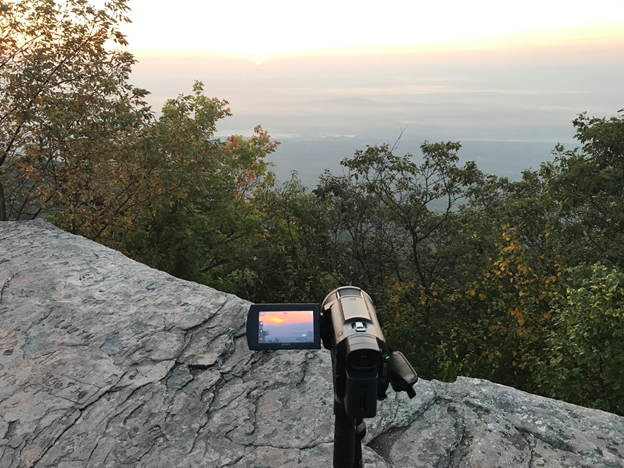
Think you’ve got stress? Find out if it’s real or fake.
Think you’ve got stress? Find out if it’s real or fake.
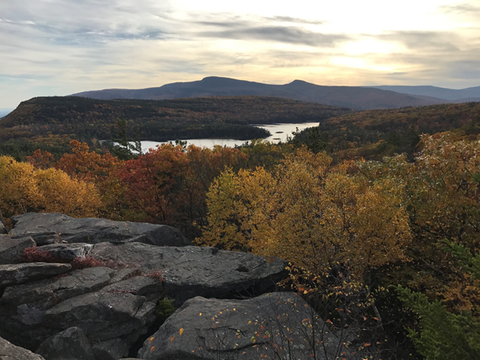
This is Sunset Rock in North Lake State Park in the Catskill Mountains of New York. This is near where I encountered a 500-pound bear.
Last week I got to experience REAL stress. I was walking along an isolated trail in the Catskill mountains when I encountered a rather large bear. He was about 25 feet away and heading right toward me. Usually my stress consists of a boatload of phony, perceived stress like getting stuck in traffic, having to wait in a long line or finding out I got the wrong sandwich in my take-out order. We were never meant to deal with this fake stress and now I think I know why.
Real stress is invigorating: You either survive it or you don’t. If you do survive it, there’s a feeling of elation that follows, fueled by a feel-good chemical reward waiting for you when you get back to the safety of your home or man-cave. You’ll be so pumped up with dopamine and endorphins, that there’s little or no bad taste leftover from the incident itself. In short, you experience the stressful event as a victory, or as Hans Selye, the “grandfather” of the stress concept would say, as eustress (or good stress).
Author of the book BEHAVE and Stanford University Professor, Dr. Robert Sapolsky explained to me in an interview, that in the wild, the fight or flight response (predator trying to catch prey) lasts on average, less than a minute. Either the predator catches the prey, or the prey gets away. The escaping animal will have activated the fight or flight response in order to run as fast as it possibly can. The key point here, is that REAL stress is not only finite, (or in the jargon of stress science; acute) but when you do survive, it’s truly invigorating.
In the modern jungle, a lot of our stressors tend to be repetitive (or in the jargon of stress science, chronic). The daily commute. The annoying coworkers and customers. The micromanaging boss. The endless deadlines. What we collectively call the daily grind. These kinds of stressors or “perceived threats”, which seem real, but really aren’t, just go on and on and on.
Anyway, around 3:00 PM last Saturday, I went for a hike in the mountains. I was on a trail I'd never been on before and I was hoping to make it to a spectacular vista called Sunset Rock. My plan was to catch the sunset, photograph it, and then return to my car, about a mile away, all before it got too dark to find my way back. Any experienced hiker would already see the fallacy in my plan.
I kept an ear open the entire time for any tell-tale signs of bears. Sometimes a squirrel jumping through the leaves can be surprisingly loud, so there were many false alarms. Repeatedly, I’d hear a squirrel but have the thought, could that be a bear? This phenomenon, where we continually assume the worst, is known as negativity bias: Better to mistake the sound of a squirrel for a bear than vice versa and end up dead because you didn’t have time to take evasive action. Interestingly, it may have been negativity bias, that allowed me to live to tell this tale.
Eventually, I heard something coming through the leaves that only sounded a bit louder than the squirrels I’d been hearing so far, but my negativity bias caused me to reflexively check it out anyway. A few seconds later a huge bear, weighing I guess about 500 pounds, popped through a row of bushes about 25 feet away. Its head was down, sniffing the ground, so I could tell it hadn’t seen me yet. I really didn’t want it that bear to come one step closer without noticing me first. In other words, I didn’t want if to keep lumbering along and then discover me a few seconds later at only 10 feet away.
What I did next, how I behaved in the face of real stress, came as complete surprise to both me and the bear.

When I saw the bear coming toward me, I was filming at the edge of a cliff. There was really no where I could go.
The bear was walking right toward me with its nose to the ground. I could tell it didn’t know I was there. I was taking pictures and shooting video at the edge of a cliff so I had no where I could run even if I had wanted to. Despite the way they lumber along, if a bear wants to catch you, it easily can. All the experts say it’s better to stand your ground and try to look as LARGE as you can, even if they charge at you. The one thing I immediately concluded was, I didn’t want that bear to get another step closer without at least KNOWING that I was there.
It's funny how your mind works in a situation like this. Time opens up and it seems to move quite slowly, yet I’m sure this entire event took maybe 5 seconds or less.
Something told me to make noise to let the bear know I was there. So, I simply yelled: Hello-o in a loud but annoyed way. It was a higher-volume version of what one does when you are trying to get someone’s attention who is standing right in front of you but is completely spacing-out. Still, as a warning gesture to a very large bear, showing annoyance, seemed to make no sense at all.
In these moments of real danger though, you get to experience something very profound: Your mind makes decisions for you. As part of the fight or flight response your thinking becomes very clear. You are fully present, but you aren’t really considering your options.
Your course of action is presented to you without any choosing. There’s no time for interpretive thought like: should I do this, or should I do that? I believe in this situation you have a direct channel to your unconscious mind. (If you’ve ever had a near miss auto-accident and wondered afterwards, how did I manage to avoid that out-of-control car coming right at me, you’ve experienced the same thing.) In these REAL stress situations, like a near-miss car accident, the unconscious mind – which has collected TONS of data about the movement of your car and the cars and people around you – simply ACTS on that data and your body RE-acts accordingly.
The fight or flight response, which is activated in the amygdala simply takes over the thinking brain and makes our decisions for us. This occurs in part, because the amygdala – with its single neuron connection to both the eyes and ears, gets auditory and visual information a split second before the thinking brain, or the pre-frontal cortex (PFC) in what emotional intelligence author, Dan Goleman calls an Amygdala Hijack. For one very brief shining moment you are being run by the operating system INSTEAD of by the user who operates the operating system.
It’s like putting your plane on autopilot except you didn’t turn the switch – the autopilot mechanism turned it on for you. Which is why when it’s over – think near miss car accident again - you say to yourself: who guided me through that crisis? Well it was you but a part of you that under normal circumstances you almost NEVER have access to, especially today in our gadget-driven world of emailing, texting, instant messaging and instagramming, that no doubt keeps all these amazing powers hidden behind this veil of digital distraction.
When my autopilot took over, it instructed me to yell out: Hello-o in kind of an annoyed way. That bear was so surprised – I could see it clearly in it’s eyes – it turned around and RAN. I spend a fair amount of time in the Catskills and I have run into plenty of bears while there. Every other time I’ve seen a black bear they keep their distance, but they don’t RUN. This bear RAN. And by the way, most of the black bears I’ve seen in the woods aren’t much bigger than a large dog. This one was the size a small Grizzly. For a black bear it was huge. So it all just confirmed my take – that my unconscious mind – having sized up all the variables in a split second – fully orchestrated and controlled JUST THE RIGHT ACTION at just the right moment.

When you are photographing the view at the edge of a cliff, you are not consciously thinking about a bear approaching. You are thinking: How can I get the best shot without falling off this cliff. But, as you will learn in this blog, your unconscious mind is listening for signs of danger all the time.
I attribute surviving my encounter with the bear in the Catskills mountains in part, to the proper activation of my fight or flight response and the advance warning I got from negativity bias. As I trekked through the woods, every time I heard “footsteps” in the leaves, I’d look up from my camera to see if it was a bear. Each time (except the last time) it turned out to be a squirrel. That’s negativity bias: Better to mistake the sound of a squirrel for a bear than the other way around.
When the bear did appear, I had advance warning. I heard the footsteps. I looked up immediately and I saw a large bear coming through the underbrush about 25 feet away. It was headed right toward me. To my surprise, it had its nose to the ground and didn’t even notice I was there. Thanks to negativity bias, I saw the bear before the bear saw me. In other words, even though there had already been many false alarms, I still looked up from my camera every time I heard anything that sounded remotely like an approaching bear. Negativity bias means, I always ASSUMED the worst-case scenario. Better to be safe than sorry.
When I saw it was a REAL BIG bear, my fight or flight response kicked into high gear. In addition to giving me the power to run faster and fight harder, the fight or flight response sends oxygen and nutrients to the major muscles and organs of the body, including the brain. As a result, I had a sudden surge in energy and mental clarity. Even though I can’t EVER imagine choosing to yell, HELLO-O in an annoyed tone at a rapidly approaching bear, that’s exactly what I did. Not only did it surprise the bear, it surprised me. When the bear heard me, it turned around and ran in the other direction.
As I wrote last week, I didn’t feel like I chose to yell Hello-o. It just happened. My brain was processing a lot of information faster than “I” could process it. Long before that moment in the woods, I had read the rules one must observe if one encounters a bear in the woods:
- Don’t run a way. That only encourages the bear to chase you down (which it easily can).
- Make sounds so the bear knows you are there.
- Stand tall; make yourself look as large as possible.
Despite knowing all this, I didn’t consciously consider my options, I just instinctually did something right away. And as it turned out, my instincts were spot on. What I did, sent the bear packing.
But as I mentioned earlier, my troubles weren’t over yet. After my encounter, for obvious reasons, I was in a hurry to get out of there. My car was sitting at the trail head, about a mile away. I’ve never had any problems seeing my way around at dusk, so I assumed my walk out would be a piece of cake. Unfortunately, when you are on a wooded trail, parts of that trail are going to be shrouded in darkness the minute the sun goes down. In that darkness you can’t see the trail very well, and you can’t see the trail markers, either.
It wasn’t long before I took a wrong turn. I managed to find my way back, but each time I took another wrong turn, I’d get increasingly edgy. That’s about when I heard – for the first time ever - a fisher cat screaming in the woods. If you’ve never heard a fisher cat watch this short video. It sounds like woman is being murdered. The sound is blood-curdling. Now I was nervous and spooked.
When I was still at a high point on the trail, I pulled out my cell phone. Service in that area was spotty at best, so I figured I better make a proactive phone call while I still could. Even though it would totally freak her out, I called my wife and let her know where I was. I calmly explained, that if she didn’t hear back from me in two hours to call the forest rangers who work in the park – or 911 and tell them where my car was and what path I was on. I told her, if I got lost again, and didn’t have cell service, I would just remain where I was, until someone found me.
After that, I gave myself a little pep talk and took a couple of deep breaths. “C’mon Jim this is definitely the kind of stress that you can handle. Just stay calm, focus on your breath, and you will make it out of here, just fine.”
I looked at my cell phone and noticed I had a lot of power left, so I decided to use it as a flashlight. With that light, I was able to find the trail markers on the trees and in about an hour (with a couple more wrong turns along the way) I made it safely out of the woods.
REAL stress is short term. When it’s over, it’s really over. And let me tell you when I saw my car – the last one left in that dark parking lot - I felt exhilarated. This is the kind of stress our bodies were built for. The fight or flight response was meant to be activated in survival situations ONLY – not in situations like traffic jams, petty arguments and sitting behind someone on a train or a bus who is talking too loud on their cell-phone. For the purposes of this article, that’s what I’m calling fake stress.
My REAL stress had a clear beginning, (when I first heard the bear) a clear middle, (when I navigated through the woods) and a clear end, when I reached the car. When it was over, I called my wife, who was far away and told her I had made it out safely. Needless to say, she was relieved. Next, I called a friend, who happened to live nearby, and we went out on the town and celebrated my victory over stress!
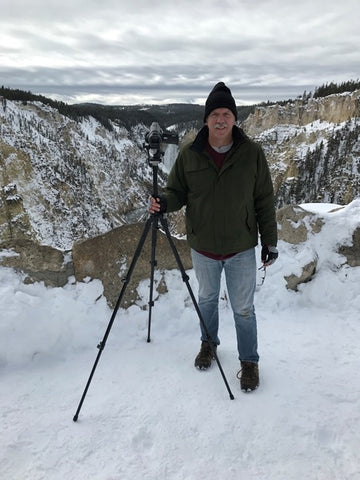
Filming THE RELAXATION CHANNEL at the Grand Canyon of Yellowstone in mid October. Despite the fact there is a foot of snow, and the bears haven’t yet gone into hibernation.
I’ve bumped into a fair number of black bears up in the Catskills and I can say from experience, these bears are generally timid, retiring and shy. They are more afraid of you than you are of them.
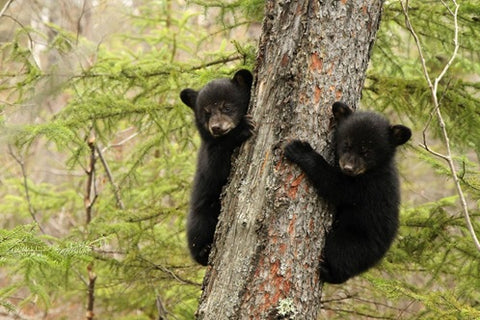
Even the several chance encounters I have had with a Momma bear and her cubs has occurred without incident. As soon as the momma bear hears you coming – she makes a distinctive noise and the cubs quickly climb the nearest tree. She stands her ground, and you back away slowly. Once you are far enough away, and clearly not a threat, she makes another distinctive noise, and the cubs climb back down. They continue foraging through the woods, and you can continue watching safely.
But this last part is not about black bears. It’s about brown bears (aka Grizzly bears) and a form of stress I haven’t talked about until now, called anticipatory stress. I recently visited Yellowstone National Park where I anticipated I would meet up with a few brown bears.
In case you are wondering, I shoot nature videos and have created a 12-hour relaxation channel for hospitals which you can see a preview of at the StressStop.com website. I spend a fair amount of time in the woods, in parks and in all kinds of beautiful places, filming what I go there to see. Now I’m trying to make a 1-hour video at all the major national parks so I can expand my 12-hour program to 24 hours. That’s why I was headed to Yellowstone.
Having never really felt threatened by black bears back East, I wondered if all this business about how fearful Grizzly bears are, was a lot of hype. So, I decided to go online to see what I could find out. When I looked on the Grand Tetons website, (I would be passing through there on the way up to Yellowstone) there was an “ALERT MESSAGE” which I clicked on. That message said: “The main road through the Park is closed until further notice due to Grizzly Bear activity.”

The Yellowstone website.
Then I went on the Yellowstone website. I clicked on: Plan your visit>safety>bear safety, and as you can see, THERE ARE FIVE SEPARATE ENTRIES FOR BEAR SAFETY. I read them all. I was starting to get a little worked up (i.e., stressed) about the potential threat of bumping into a bear.
There was lots more information about what to do if you encountered a bear: Stand your ground, back away slowly, look as tall as you can, play dead if you have to, but don’t drop to the ground until the last second. Wear a backpack to protect your flank; fold your hands over the back of your head. It even quoted the exact number of fatal bear attacks in Yellowstone over the last five years. Check out this section of their website and you will see how in depth, and matter of fact, this coverage is, with exact data, and percentages of how likely you will be to survive if you play dead vs. if you fight back.
In this whole blog I’ve been emphasizing the difference between REAL stress – a real threat to your safety – like an encounter with a bear vs. what (for the purposes of this article) I’m calling FAKE stress, like getting stuck in a traffic jam or being criticized by your co-worker or getting the wrong sandwich in your take-out order. These are all examples of perceived threats – not real ones.
But anticipatory stress, is when you get worked up about any threat (real or imaginary) that’s in the future. It’s different from anxiety, which can be free floating, and not necessarily attached to a specific threat or cause. Anticipatory stress is the what you experience before a root canal, a final exam, or elective surgery. When I arrived at the visitor’s center in Jackson, Wyoming, and started discussing whether I needed to buy a can of bear spray, that’s when I noticed that my anticipatory stress was starting to rise.
Believe me, I’m as vulnerable to all kinds of stress as anyone else, but I also realize, that stress is constantly trying to play a game inside your own head. It always wants to trick you into thinking that something is going to be much worse than it actually it is. But let’s face it, all those articles on the Yellowstone website, were quite factual. So, what is the message of anticipatory stress in this particular case? What was it trying to tell me? And was this stress real or fake?
The answer is, it was a REAL threat, but it wasn’t threatening me at that moment. Still, when the park ranger in the Jackson took me out behind the visitor’s center and we practiced how to use the bear spray, the anticipated threat felt very real.
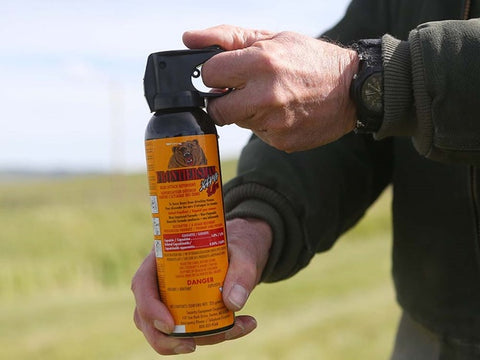
Nonetheless, the only thing I needed to really worry about at that moment – was not the bear – but whether to buy the bear spray. The little canister, which looked like a miniature fire extinguisher, cost $50. Part of me was saying, that’s expensive. I bet you won’t even need it. And the other part of me was saying, get it now. I bought the bear spray.
As I hiked and filmed all through Yellowstone I didn’t encounter a single bear. But I noticed all the experienced hikers, (not the tourists) carried bear spray. That led me to believe that the threat was very real. But in order to determine how big a threat it actually was, I asked everyone I saw with bear spray: Have you ever had to actually use it? I must have asked at least ten people. No, was the only answer I heard. (And that included the Park Ranger who taught me how to use it at the visitor’s center.)
On the last day in Yellowstone, I encountered a professional photographer, with a can of bear spray attached to his belt. He had spent many days in the park on long hikes, shooting photos and doing it all with no companion. (The website says, for safety reasons, you should always hike with at least two other people.) Here was the acid test. I asked him: Have you ever had to use the bear spray?
“No,” he said. “There were times when I probably should have, but I have never actually used it.”
So, if you think you are experiencing anticipatory stress, listen carefully to the message your stress is trying to convey. It isn’t necessarily, don’t do what you are stressing about. It’s more likely to be saying: PAY ATTENTION; BE CAREFUL; BE PREPARED. When you understand the roll of anticipatory stress, you can use it to your advantage, rather than falling prey to immobilizing fear. Once I had taken the necessary precautions and had a reasonable understanding of the ACTUAL danger – I was able to do what I needed to do, with much more confidence, and much less fear.





James Porter
Author